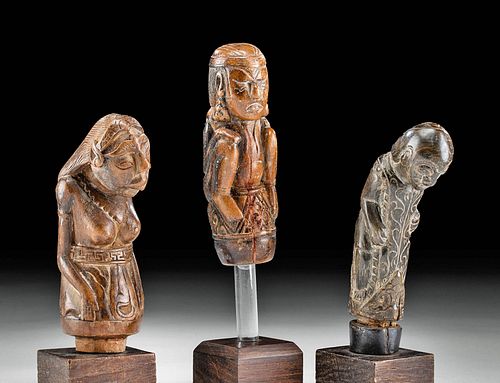Three 19th C. Indonesian Wood Figural Kris Handles
Lot 80
About Seller
Artemis Fine Arts
686 S Taylor Ave, Ste 106
Louisville, CO 80027
United States
Selling antiquities, ancient and ethnographic art online since 1993, Artemis Gallery specializes in Classical Antiquities (Egyptian, Greek, Roman, Near Eastern), Asian, Pre-Columbian, African / Tribal / Oceanographic art. Our extensive inventory includes pottery, stone, metal, wood, glass and textil...Read more
Categories
Estimate:
$600 - $900
Absentee vs Live bid
Two ways to bid:
- Leave a max absentee bid and the platform will bid on your behalf up to your maximum bid during the live auction.
- Bid live during the auction and your bids will be submitted real-time to the auctioneer.
Bid Increments
| Price | Bid Increment |
|---|---|
| $0 | $25 |
| $300 | $50 |
| $1,000 | $100 |
| $2,000 | $250 |
| $5,000 | $500 |
| $10,000 | $1,000 |
| $20,000 | $2,500 |
| $50,000 | $5,000 |
| $100,000 | $10,000 |
| $200,000 | $20,000 |
About Auction
By Artemis Fine Arts
Mar 4, 2021
Set Reminder
2021-03-04 10:00:00
2021-03-04 10:00:00
America/New_York
Bidsquare
Bidsquare : Ancient | Ethnographic Art Through The Ages
https://www.bidsquare.com/auctions/artemis-gallery/ancient-ethnographic-art-through-the-ages-6467
Ancient art from Egypt, Greece, Italy and the Near East, as well as Asian, Fossils, Pre-Columbian, Native American, African / Tribal / Oceanic, Fine art, and much more! All categories, all price ranges... all legally acquired and guaranteed to be as described or your money back. Artemis Fine Arts info@artemisfinearts.com
Ancient art from Egypt, Greece, Italy and the Near East, as well as Asian, Fossils, Pre-Columbian, Native American, African / Tribal / Oceanic, Fine art, and much more! All categories, all price ranges... all legally acquired and guaranteed to be as described or your money back. Artemis Fine Arts info@artemisfinearts.com
- Lot Description
Southeast Asia, Indonesia, ca. late 19th century. A gorgeous ensemble of three finely-carved, wooden kris handles, all with figural forms. Presenting in a hue of caramel brown, the first depicts a bare-chested woman bowing her head forward and turning slightly to her left as her lengthy hair cascades down her back. Her tranquil visage displays full lips, a pointed nose, large, elegant eyes, and a thick unibrow, all flanked by pointed, elf-like ears. She is adorned with a long, undulating necklace that falls beneath her breasts, two arm bands, a dotted headband, and a flowing skirt that hangs from a belt adorned by maze motifs. The second handle, also of a caramel hue, is carved in the form of a male figure seated on a decorative plinth with his legs drawn up before him. Size of largest: 1.5" W x 4.375" H (3.8 cm x 11.1 cm); 5.25" H (13.3 cm) on included custom stand.
Capped by carefully incised, chin-length hair and a hemispherical headdress, the intriguing figure showcases a huge head with a bow-lipped frown, a bulbous nose, and closed eyes under a narrowed brow. His hands rest atop his legs on both sides of his rotund belly, and sizable adornments hang from his ears. The last kris handle is carved in the form of a deep-bowing male figure seated on an embellished stool, all presenting in a shade of mocha brown. Draped in a long robe with a swirling motif over a tunic, he places one hand on his stomach and the other at his side. Topped with a petite headdress, his visage shows two almond-shaped eyes held wide-open under an arched brow, a flat nose, and a straight mouth, all flanked by two giant ears.
The kris is both a weapon and a spiritual object. The oldest known are from the 10th century CE; they are thought to have originated on the island of Java. The bladesmith, called an empu, formed the blade from layers of different iron ores and meteorite nickel. In high quality ones, the metal is folded dozens or even hundreds of times. Traditionally, krises were worn every day as well as for special ceremonies; both men and women wore them. They were passed down through families. They were also used for display, as talismans with magical powers, weapons, heirlooms, accessories for ceremonial dress, and indicators of social status.
Provenance: private Newport Beach, California, USA collection
All items legal to buy/sell under U.S. Statute covering cultural patrimony Code 2600, CHAPTER 14, and are guaranteed to be as described or your money back.
A Certificate of Authenticity will accompany all winning bids.
We ship worldwide and handle all shipping in-house for your convenience.
#162767Male with legs drawn up has fissure from base up to his head with clay or putty over the break line, making it difficult for him to fit onto his stand. Bowing male has minor fissure near bottom. All have expected surface wear with light nicks, scratches, and some softening of details, commensurate with age. Otherwise, all are very nice with lovely earthen deposits in recessed areas.Condition
- Shipping Info
-
All shipping is handled in-house for your convenience. Your invoice from Artemis Gallery will include shipping calculation instructions. If in doubt, please inquire BEFORE bidding for estimated shipping costs for individual items.
-
- Buyer's Premium



 EUR
EUR CAD
CAD AUD
AUD GBP
GBP MXN
MXN HKD
HKD CNY
CNY MYR
MYR SEK
SEK SGD
SGD CHF
CHF THB
THB














